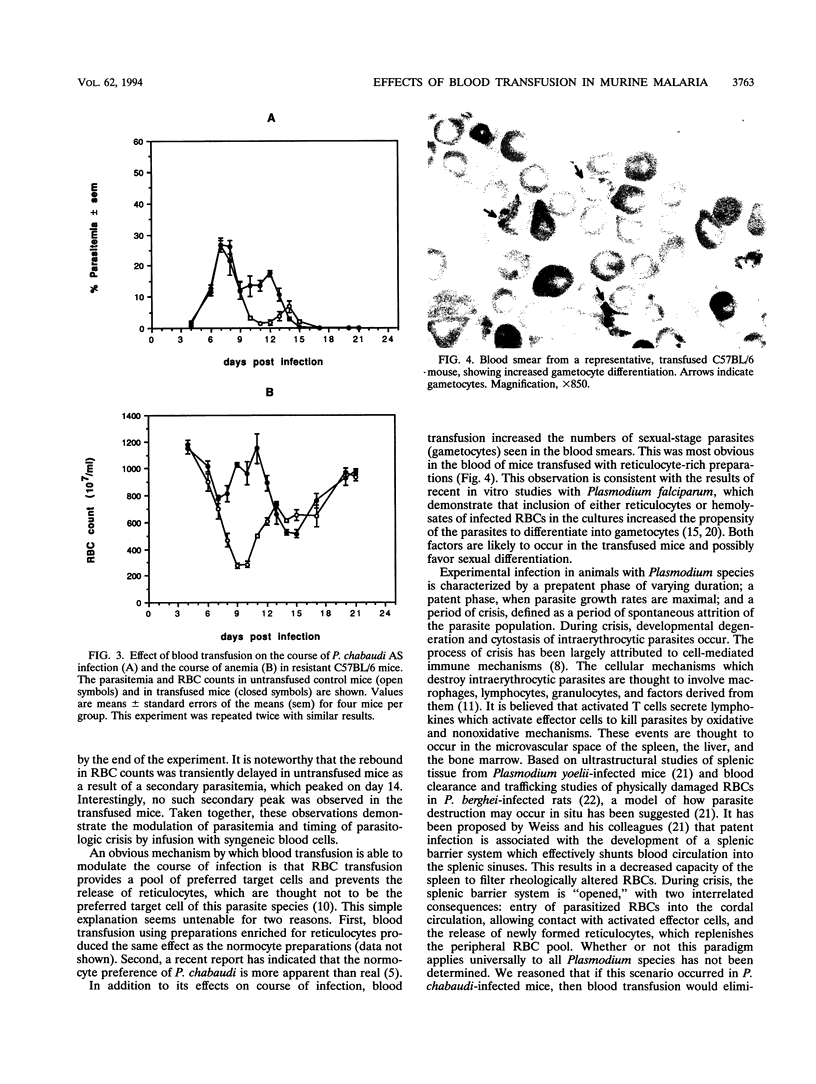Abstract
The importance of severe anemia in the mortality of susceptible A/J mice during blood-stage Plasmodium chabaudi AS infection was assessed. Blood transfusion during and 2 to 3 days after peak parasitemia rescued 90% of susceptible mice from severe anemia and death and allowed these mice to clear the infection and acquire immunity to reinfection. However, blood transfusion prolonged the patency of the infection for up to 5 days after peak parasitemia. Blood transfusions in resistant C57BL/6 mice produced an identical effect, that is, prolongation of the patency of parasitemia. In addition, blood transfusion increased the numbers of gametocytes in both mouse strains. In both strains of mice, the rapid reduction in parasitemia, which occurs during crisis, was associated with the development of moderate levels of anemia. The possible mechanisms for the modulation of parasitemia by blood transfusion and the implications of the present observations for our understanding of the events which occur during crisis are discussed. It is proposed that parasitologic crisis is induced and/or maintained by physiological alterations associated with anemia.
Full text
PDF




Images in this article
Selected References
These references are in PubMed. This may not be the complete list of references from this article.
- Barnwell J. W., Desowitz R. S. Studies on parasitic crisis in malaria: I. Signs of impending crisis in Plasmodium berghei infections of the white rat. Ann Trop Med Parasitol. 1977 Dec;71(4):429–433. doi: 10.1080/00034983.1977.11687208. [DOI] [PubMed] [Google Scholar]
- Cavacini L. A., Guidotti M., Parke L. A., Melancon-Kaplan J., Weidanz W. P. Reassessment of the role of splenic leukocyte oxidative activity and macrophage activation in expression of immunity to malaria. Infect Immun. 1989 Dec;57(12):3677–3682. doi: 10.1128/iai.57.12.3677-3682.1989. [DOI] [PMC free article] [PubMed] [Google Scholar]
- Cavacini L. A., Parke L. A., Weidanz W. P. Resolution of acute malarial infections by T cell-dependent non-antibody-mediated mechanisms of immunity. Infect Immun. 1990 Sep;58(9):2946–2950. doi: 10.1128/iai.58.9.2946-2950.1990. [DOI] [PMC free article] [PubMed] [Google Scholar]
- Hejna J. M., Rencricca N. J., Coleman R. M. Effective recovery and immunity to virulent malaria following red cell transfusion at crisis. Proc Soc Exp Biol Med. 1974 Jun;146(2):462–464. doi: 10.3181/00379727-146-38126. [DOI] [PubMed] [Google Scholar]
- Jarra W., Brown K. N. Invasion of mature and immature erythrocytes of CBA/Ca mice by a cloned line of Plasmodium chabaudi chabaudi. Parasitology. 1989 Oct;99(Pt 2):157–163. doi: 10.1017/s0031182000058583. [DOI] [PubMed] [Google Scholar]
- Meding S. J., Langhorne J. CD4+ T cells and B cells are necessary for the transfer of protective immunity to Plasmodium chabaudi chabaudi. Eur J Immunol. 1991 Jun;21(6):1433–1438. doi: 10.1002/eji.1830210616. [DOI] [PubMed] [Google Scholar]
- Naotunne T. S., Karunaweera N. D., Del Giudice G., Kularatne M. U., Grau G. E., Carter R., Mendis K. N. Cytokines kill malaria parasites during infection crisis: extracellular complementary factors are essential. J Exp Med. 1991 Mar 1;173(3):523–529. doi: 10.1084/jem.173.3.523. [DOI] [PMC free article] [PubMed] [Google Scholar]
- Ott K. J. Influence of reticulocytosis on the course of infection of Plasmodium chabaudi and P. berghei. J Protozool. 1968 May;15(2):365–369. doi: 10.1111/j.1550-7408.1968.tb02138.x. [DOI] [PubMed] [Google Scholar]
- Podoba J. E., Stevenson M. M. CD4+ and CD8+ T lymphocytes both contribute to acquired immunity to blood-stage Plasmodium chabaudi AS. Infect Immun. 1991 Jan;59(1):51–58. doi: 10.1128/iai.59.1.51-58.1991. [DOI] [PMC free article] [PubMed] [Google Scholar]
- Rockett K. A., Targett G. A., Playfair J. H. Killing of blood-stage Plasmodium falciparum by lipid peroxides from tumor necrosis serum. Infect Immun. 1988 Dec;56(12):3180–3183. doi: 10.1128/iai.56.12.3180-3183.1988. [DOI] [PMC free article] [PubMed] [Google Scholar]
- Rzepczyk C. M., Clark I. A. Demonstration of a lipopolysaccharide-induced cytostatic effect on malarial parasites. Infect Immun. 1981 Aug;33(2):343–347. doi: 10.1128/iai.33.2.343-347.1981. [DOI] [PMC free article] [PubMed] [Google Scholar]
- Schneweis S., Maier W. A., Seitz H. M. Haemolysis of infected erythrocytes--a trigger for formation of Plasmodium falciparum gametocytes? Parasitol Res. 1991;77(5):458–460. doi: 10.1007/BF00931646. [DOI] [PubMed] [Google Scholar]
- Smith L. P., Hunter K. W., Oldfield E. C., Strickland G. T. Murine malaria: blood clearance and organ sequestration of Plasmodium yoelii-infected erythrocytes. Infect Immun. 1982 Oct;38(1):162–167. doi: 10.1128/iai.38.1.162-167.1982. [DOI] [PMC free article] [PubMed] [Google Scholar]
- Stevenson M. M., Ghadirian E., Phillips N. C., Rae D., Podoba J. E. Role of mononuclear phagocytes in elimination of Plasmodium chabaudi AS infection. Parasite Immunol. 1989 Sep;11(5):529–544. doi: 10.1111/j.1365-3024.1989.tb00687.x. [DOI] [PubMed] [Google Scholar]
- Stevenson M. M., Lyanga J. J., Skamene E. Murine malaria: genetic control of resistance to Plasmodium chabaudi. Infect Immun. 1982 Oct;38(1):80–88. doi: 10.1128/iai.38.1.80-88.1982. [DOI] [PMC free article] [PubMed] [Google Scholar]
- Taylor-Robinson A. W., Phillips R. S., Severn A., Moncada S., Liew F. Y. The role of TH1 and TH2 cells in a rodent malaria infection. Science. 1993 Jun 25;260(5116):1931–1934. doi: 10.1126/science.8100366. [DOI] [PubMed] [Google Scholar]
- Trager W., Gill G. S. Enhanced gametocyte formation in young erythrocytes by Plasmodium falciparum in vitro. J Protozool. 1992 May-Jun;39(3):429–432. doi: 10.1111/j.1550-7408.1992.tb01476.x. [DOI] [PubMed] [Google Scholar]
- Weiss L., Geduldig U., Weidanz W. Mechanisms of splenic control of murine malaria: reticular cell activation and the development of a blood-spleen barrier. Am J Anat. 1986 Jul;176(3):251–285. doi: 10.1002/aja.1001760303. [DOI] [PubMed] [Google Scholar]
- Wyler D. J., Quinn T. C., Chen L. T. Relationship of alterations in splenic clearance function and microcirculation to host defense in acute rodent malaria. J Clin Invest. 1981 May;67(5):1400–1404. doi: 10.1172/JCI110168. [DOI] [PMC free article] [PubMed] [Google Scholar]
- Yap G. S., Stevenson M. M. Plasmodium chabaudi AS: erythropoietic responses during infection in resistant and susceptible mice. Exp Parasitol. 1992 Nov;75(3):340–352. doi: 10.1016/0014-4894(92)90219-z. [DOI] [PubMed] [Google Scholar]




